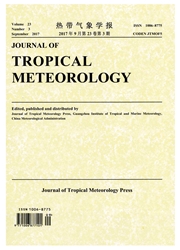

 中文摘要:
中文摘要:
我们从在气候上参予了对 Intergovernmental 面板的第四个评价( AR4 )的模型改变的气候( IPCC )使用了产量评估南方亚洲人夏天季风( SASM )和东方亚洲夏天季风( EASM )发行量的回答到在土地和海洋上的不同温暖在下面一种中等温暖情形, SRES A1B 。我们的结果建议那,尽管在西藏的高原( TP )上的近表面的温暖在热带印度洋( TIO )和西北的太平洋( NWP )上比那大, upper-tropospheric 陆地海在 TP 和 TIO ( TP-TIO )之间并且在 TP 和 NWP ( TP-NWP )之间的热对比将减少。在 interdecadal 和更长的时间规模,在 SASM 发行量的变化与 TP-TIO 上面对流层的热对比一致。相反地,在 EASM 发行量的变化与 TP-NWP 降低对流层的热对比一致。在 interannual 时间规模,然而,在 EASM 和 SASM 的两个变化显著地与上面对流层的热对比被相关。进一步的分析建议那在潮湿增加并且在全球温暖导致的云盖子变化可以引起在在这些区域上在垂直温度分发导致不一致的变化的 TP 和海洋上温暖的放大 upper-tropospheric。因为在 TIO 和 NWP 上温暖在 TP,南方的 TP-TIO 和 TP-NWP 上比那大,带的热对比将两个都减少。然而在更低的层,在在在在 TP 的近表面的区域的更大的热效果的土地和海结果之间的热能力的差别比那些在包围海洋上。我们证明影响热条件的因素的一个范围将多半在一种温暖的情形下面越过时间规模的一个范围在亚洲季风引起变化。这些变化在温室效应和自然可变性的影响反映差别。
 英文摘要:
英文摘要:
We used outputs from climate models that participated in the fourth assessment (AR4) of the Intergovernmental Panel on Climate Change (1PCC) to evaluate the responses of the South Asian summer monsoon (SASM) and the East Asian summer monsoon (EASM) circulations to different warming over land and ocean under a medium warming scenario, SRES A1B. Our results suggest that, even though near-surface warming over the Tibetan Plateau (TP) is greater than that over the tropical Indian Ocean (TIO) and the northwestern Pacific (NWP), the upper-tropospheric land-sea thermal contrasts between the TP and the TIO (TP-TIO) and between the TP and the NWP (TP-NWP) will decrease. At interdecadal and longer time scales, the change in the SASM circula- tion is consistent with the TP-TIO upper-troposphere thermal contrast. Conversely, the change in the EASM circulation is con- sistent with the TP-NWP lower-troposphere thermal contrast. However, at the interannual time scale, both changes in the EASM and SASM are significantly correlated with the upper-troposphere thermal contrast. Further analyses suggest that increases in moisture and changes in cloud cover induced by global warming may cause amplified upper-tropospheric warming over the TP and the oceans resulting in inconsistent changes in the vertical temperature distribution over these regions, Because the warming over the TIO and NWP is greater than that over the TP, the TP-TIO meridional and TP-NWP zonal thermal contrasts will both decrease. However, at the lower layer, the difference in thermal capacity between land and sea result in a larger thermal effect in the near-surface region of the TP than those over the surrounding oceans. We showed that a range of factors that affect thermal conditions will likely cause changes in the Asian monsoon across a range of time scales under a warming scenario. These changes reflect differences in the influence of the greenhouse effect and natural variability.
 同期刊论文项目
同期刊论文项目
 同项目期刊论文
同项目期刊论文
 期刊信息
期刊信息
